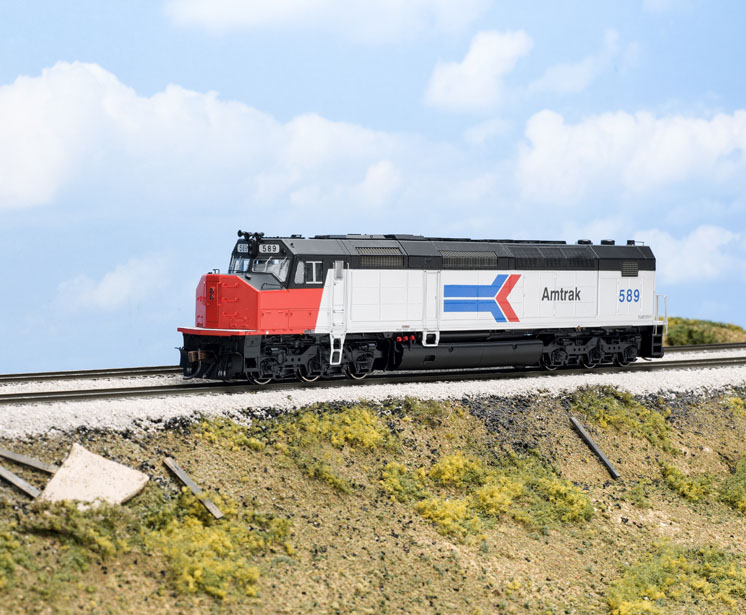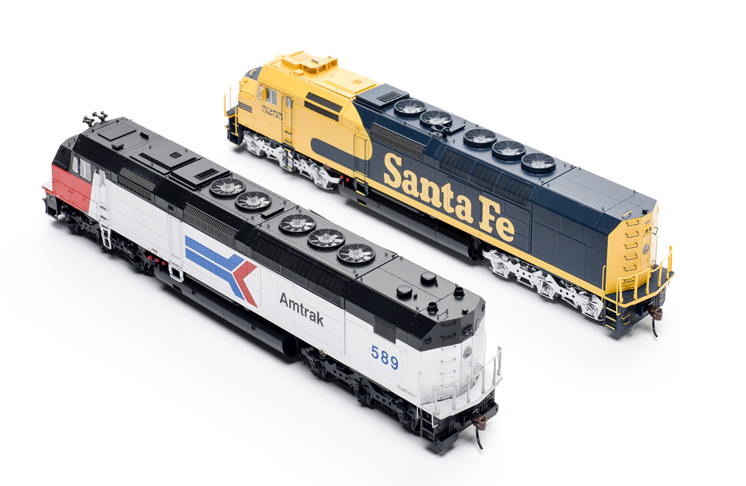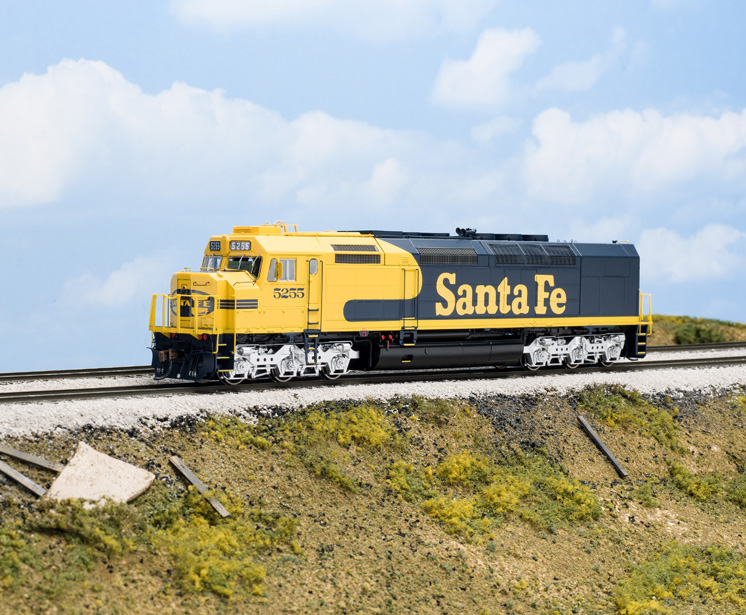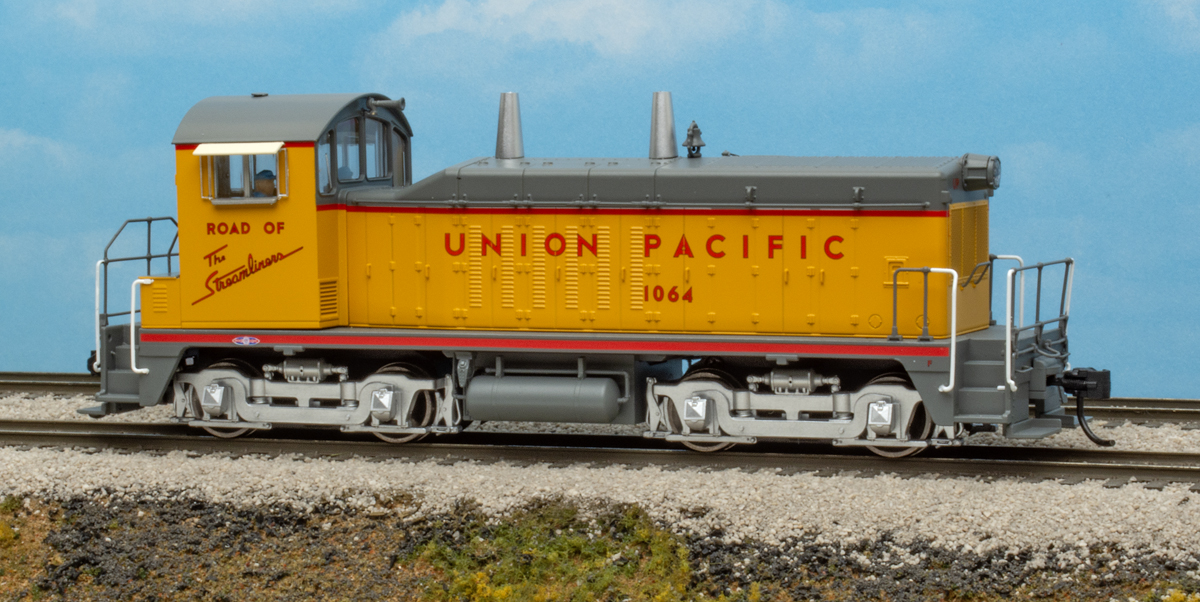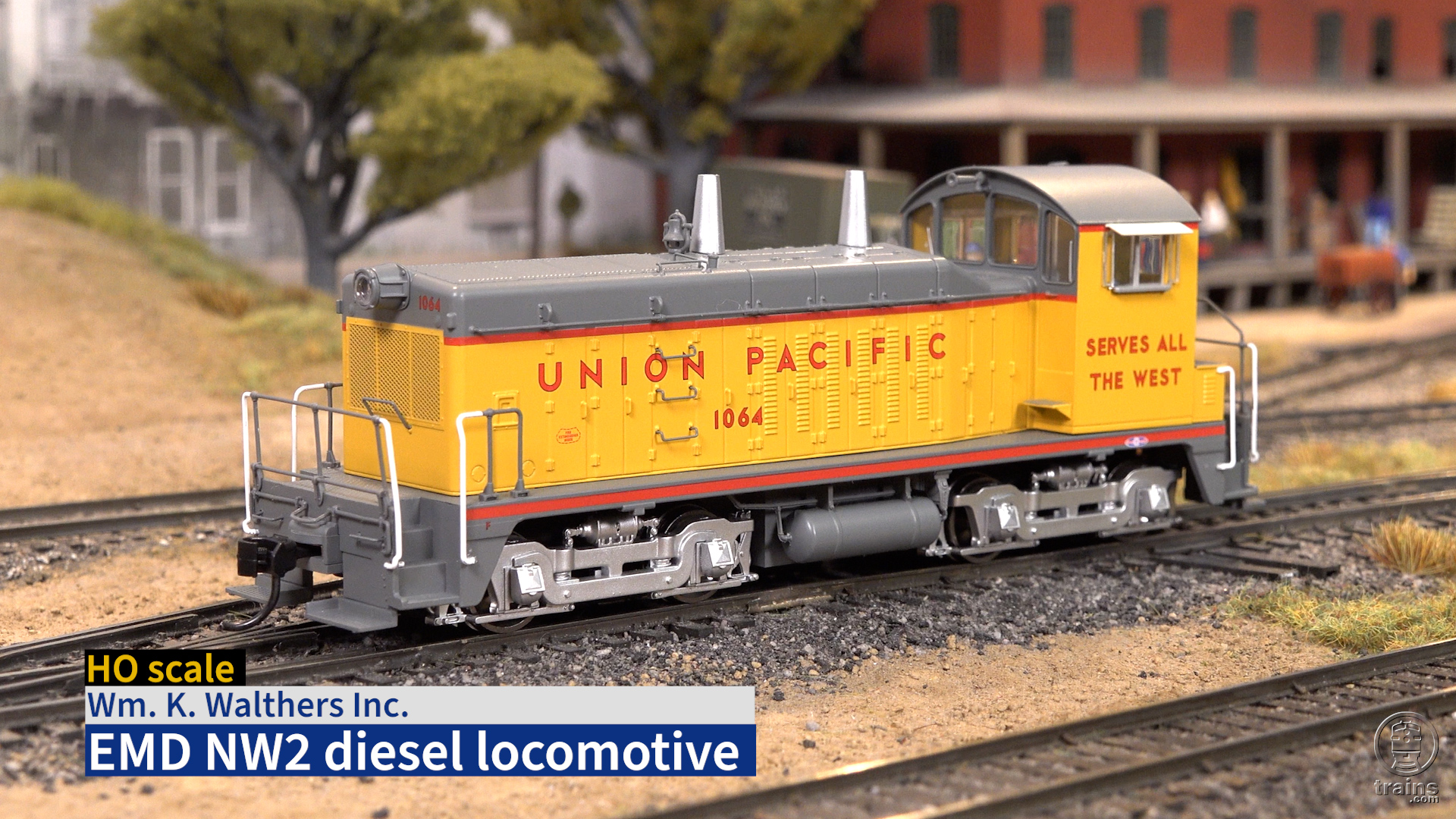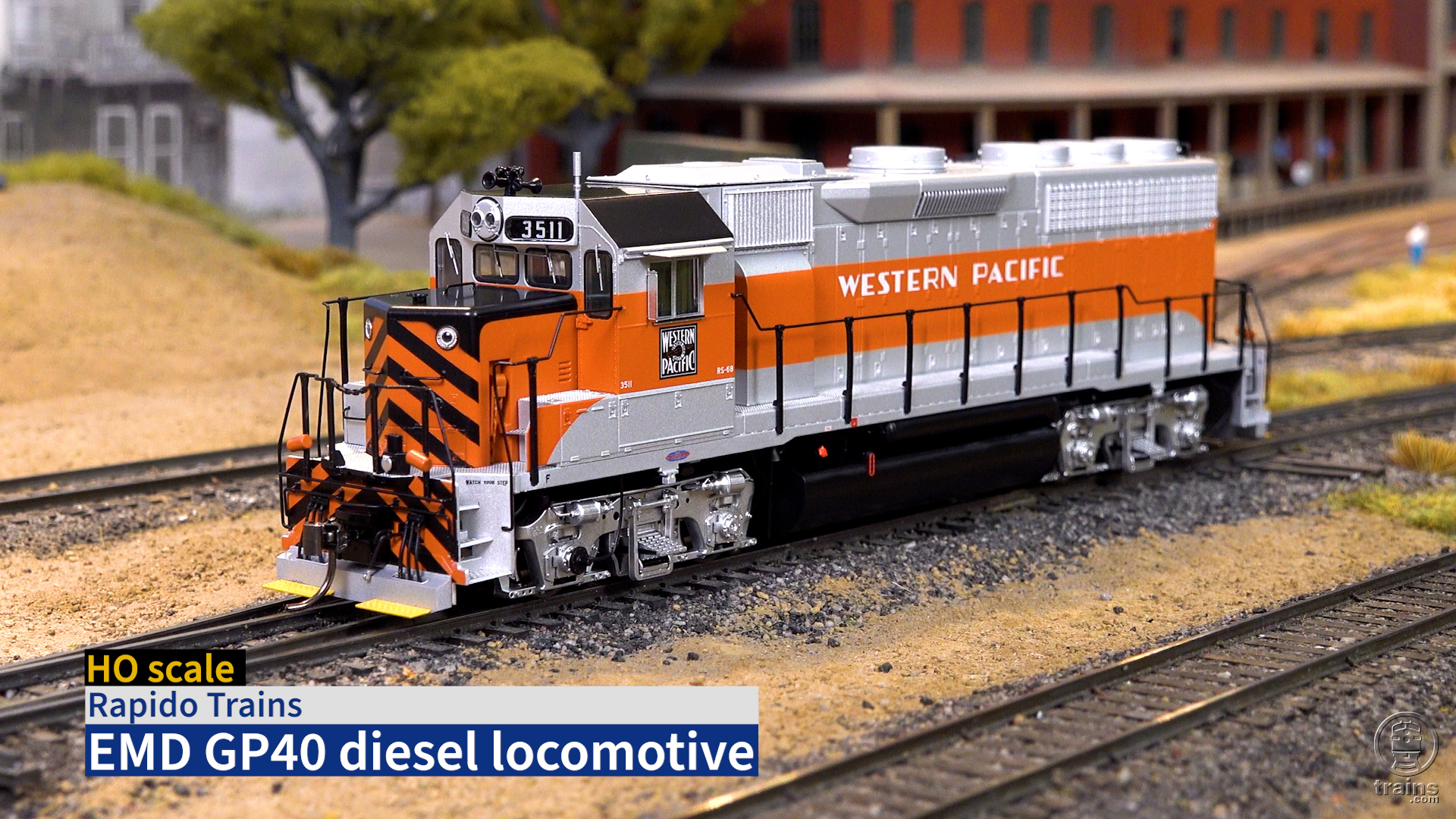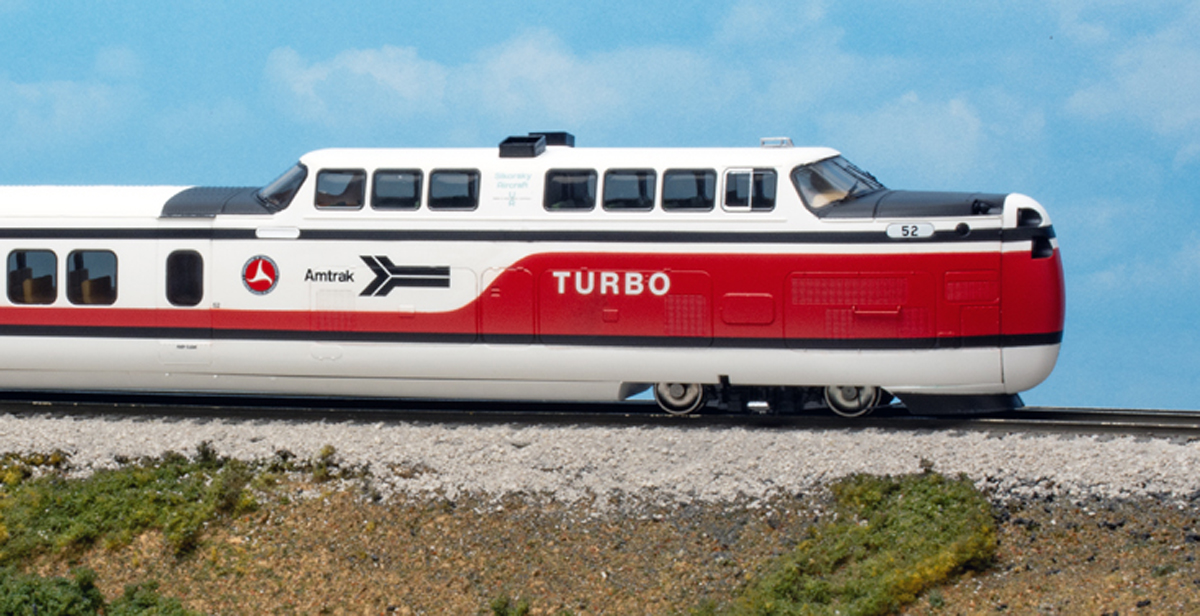Amtrak’s first all-new passenger diesel joins the Athearn Genesis line of superdetailed HO scale locomotives. This model is also the first that we’ve tested to come factory-equipped with the new-and-improved SoundTraxx Tsunami2 decoder.
The prototype. From 1973 to 1974, General Motors Electro-Motive Division built 150 SDP40F diesel-electric locomotive for Amtrak. Formed in 1971, the fledgling government-funded passenger carrier had been using hand-me-down equipment from predecessor railroads. The six-axle cowl-body SDP40Fs were built primarily for Amtrak passenger service and included steam generator equipment for heating passenger cars. Internally, the locomotive was based on the EMD SD40-2 freight hauler and featured a 3,000 hp 645E3 diesel engine.
Unfortunately the SDP40Fs proved prone to derailments. Unable to fix the problem, Amtrak removed all SDP40Fs from service by 1981. Most were traded back to EMD, but 18 were traded to the Atchison, Topeka & Santa Fe Ry., which modified them for freight service. Re-classed SDF40-2s, these freight locomotives served on the Santa Fe and its successor Burlington Northern Santa Fe Ry. All SDF40-2s were retired by 2002.
The model. The dimensions of the Athearn model match prototype drawings published in the August 1992 Model Railroader. With its twin air horns and flat nose, our review sample, Amtrak no. 589, models what railfans refer to as a phase II SDP40F. Earlier production phase I SDP40Fs had pointed noses and a single four-chime horn. Athearn is making both Amtrak versions, as well as multiple versions of the ATSF SDF40-2.
The well-defined panel lines and other molded details also match prototype drawings and photos. The pilot decks feature realistic anti-skid texture.
The model’s many separate detail parts include all handrails and grab irons, windshield wipers, m.u. hoses, and clear window glazing. The rooftop is especially well detailed, with see-through grills and separate radiator fans. The vent and Sinclair “ice skate” antenna on the cab roof are correct for the Amtrak prototype.
The model is painted in Amtrak’s phase 1 paint scheme. There’s sharp color separation, and all lettering and graphics are properly placed, including the “pointless arrow” logo on the sides.
The HT-C trucks are well done with separate brake cylinders. The front truck includes a speedometer cable on the fireman’s side of its first axle. The flexible plastic sand lines are mounted high enough to avoid catching on trackwork.
Under the hood. After removing the couplers and two screws on the underframe, I could lift off the plastic body shell. This reveals a detailed cab interior with control panels and three separately applied and painted seats. Although crew figures aren’t included, they would be easy for a modeler to add.
Behind the cab section, the five-pole, skew-wound motor with dual brass flywheels rests in the center of the die-cast metal frame. Driveshafts on each end of the motor transfer power to the truck-mounted gearboxes.
The SoundTraxx Tsunami2 decoder is attached to the frame above the motor. Two 28mm round speakers are also mounted atop the frame. One speaker is behind the cab, and the other is under the steam generator stacks.
Performance. All-wheel drive helps make this locomotive a powerful puller. As measured with our workshop force meter, the locomotive’s drawbar pull is equivalent to 21 HO passenger cars or 42 HO freight cars on straight and level track. During real-world testing on our staff layout, the Milwaukee, Racine & Troy, the SDP40F hauled 10 HO passenger cars up a 3 percent grade.
Although it doesn’t include a CurrentKeeper capacitor system, the model rolled through yard ladders and crossovers without so much as a headlight flicker, thanks to its all-wheel electrical pickup.
On our DCC test track with its decoder set to 28 speed steps, the SDP40F accelerated smoothly from 5 to 85 scale mph. The prototype could reach about 103 mph.
After setting the decoder to 128 speed steps, I had more precise slow-speed control. The model then crawled along at 1 scale mph in speed step 1. For further fine-tuning, the decoder supports both custom and 16 preset speed tables.
Tsunami2. The Tsunami2-equipped SDP40F is louder than any previous Tsunami-equipped HO locomotive that I’ve tested. Configuration variables (CVs) control the main volume level as well as the volume level of each individual sound effect.
The Tsunami2 uses indexed CVs, which allow more programming options than previous Tsunami decoders. For example, the new decoder has a feature called Flex-Map technology. I could map a particular user-triggered function to any available throttle key. With earlier Tsunami decoders, function mapping was limited to specific combinations of keys and functions.
The decoder includes an improved version of Digital Dynamic Exhaust (DDE), which uses back-electromotive force to automatically adjust the intensity of the prime mover sound. When I ran the locomotive uphill or with a heavy train, the engine rpm notched up accordingly. When I ran the locomotive light or downgrade, the rpm decreased.
For those who prefer, the decoder also supports manual notching, where function keys control the RPM level independent of the throttle setting.
Compared to the previous Tsunami, more user-triggered effects are available by default on the Tsunami2. The usual and most useful effects are still there, including the lights, bell, coupler clank, and long and short horn blasts. Other effects include a fuel-loading sequence, a general maintenance sequence, and an “All aboard” announcement from the conductor. Random cab radio chatter can also be turned on or off.
The enhanced brake functions are among my favorite features. After adding some momentum into the decoder, I programed three different braking rates: the independent brake, the train brake, and the dynamic brake. For example, when the locomotive is running light in the yard, I select the independent brake. In this case, the locomotive stops quicker than if it had a heavy train behind it. If it were hauling cars, then I’d select the train brake and plan for an increased stopping distance.
On a downgrade, I pressed function 4 and triggered the buzzing sound of the dynamic brake fans. With another press, the locomotive actually slowed down according to the rate that I programmed.
I also changed the model’s address; switched the headlights to manual, non-directional control; and consisted the SDP40F with another decoder-equipped passenger locomotive. An excellent Tsunami2 User Guide that includes a handy CV calculator is available as a free download at www.SoundTraxx.com.
DC operation. During direct-current (DC) testing, the sounds and lights turned on at 7 volts, but the model didn’t start moving until I applied 9 volts to the track. The model’s 45 scale mph top speed at 12V is a lot less than the prototype. However, it would be a comfortable operating speed for the condensed main lines of most model railroads.
In DC, the lights operate according to direction and the sounds are limited to the prime mover. Running the locomotive with a DC sound controller like the MRC Tech 6 allows access to user-triggered sound effects and CV programming on a DC layout.
Realistic sound and control from the Tsunami2 and meticulous attention to detail make the Athearn Genesis SDP40F the definitive HO scale model of this long-distance passenger hauler.
Price: $309.98 (DCC sound), $219.98 (DC, no sound)
Manufacturer
Athearn
1600 Forbes Way, Suite 120
Long Beach, CA 90810
www.athearn.com
Era: 1971 to 1981 (Amtrak)
Road names: Amtrak; Atchison, Topeka & Santa Fe
Features
• 21-pin DCC socket (DC version)
• Light-emitting-diode headlights, Gyralite, and number boxes
• McHenry plastic operating knuckle couplers at correct height
• Metal RP-25 contour wheels, in gauge
• Minimum radius: 18″, 22″ (recommended)
• Weight: 1 pound, 10.4 ounces





